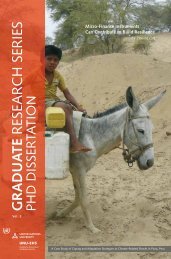Unveiling Women as Pillars of Peace Peace Building in ...
Unveiling Women as Pillars of Peace Peace Building in ...
Unveiling Women as Pillars of Peace Peace Building in ...
You also want an ePaper? Increase the reach of your titles
YUMPU automatically turns print PDFs into web optimized ePapers that Google loves.
Education campaigns target<strong>in</strong>g the various groups, particularly government <strong>of</strong>ficials were<br />
organised with<strong>in</strong> the framework <strong>of</strong> the DDC. Each workshop identified the next target group<br />
depend<strong>in</strong>g on whom the participant viewed <strong>as</strong> requir<strong>in</strong>g exposure to civic education. Chiefs and<br />
sub-chiefs with leadership tra<strong>in</strong><strong>in</strong>g were among the beneficiaries <strong>of</strong> these workshops. Their<br />
tra<strong>in</strong><strong>in</strong>g focussed particularly on the repealed Chief’s Act and the exercise <strong>of</strong> authority with<strong>in</strong> a<br />
multiparty framework. These helped them appreciate the chang<strong>in</strong>g political landscape and the<br />
need to deal with the expand<strong>in</strong>g political arena. Other groups <strong>of</strong> civil servants exposed to the civic<br />
and peace education <strong>in</strong>clude the police, military personnel and adm<strong>in</strong>istrative <strong>of</strong>ficers, particularly<br />
the District Officers. In all these c<strong>as</strong>es, government <strong>of</strong>ficers atta<strong>in</strong>ed a better understand<strong>in</strong>g <strong>of</strong> the<br />
challenges fac<strong>in</strong>g Wajir District. Given the high turnover <strong>of</strong> civil servants, these workshops are<br />
organised regularly. 3<br />
Export<strong>in</strong>g <strong>Peace</strong><br />
Between 1993 and 1997, peace activities were b<strong>as</strong>ed <strong>in</strong> Wajir District only. However,<br />
be<strong>in</strong>g a neighbour to trouble-ridden districts <strong>of</strong> Garissa, Isiolo, Mandera and Marsabit, meant that<br />
conflicts <strong>in</strong> these districts had the potential <strong>of</strong> spill<strong>in</strong>g over <strong>in</strong>to Wajir. The m<strong>as</strong>sacre at Bagalla<br />
had brought this lesson home. Besides, ow<strong>in</strong>g to the social clan structure, communities <strong>in</strong> Wajir<br />
have relations <strong>in</strong> these districts and beyond the borders <strong>of</strong> Kenya. For peace to be susta<strong>in</strong>able <strong>in</strong><br />
Wajir, therefore, required peaceful coexistence with communities <strong>in</strong> neighbour<strong>in</strong>g districts. This<br />
reality became a b<strong>as</strong>is for nurtur<strong>in</strong>g an <strong>in</strong>ter-district understand<strong>in</strong>g and peaceful coexistence.<br />
In November 1998, a regional workshop brought the Districts <strong>of</strong> North E<strong>as</strong>tern, E<strong>as</strong>tern,<br />
and Nairobi together. The delegates attend<strong>in</strong>g this meet<strong>in</strong>g agreed that peace workers <strong>in</strong> Wajir<br />
should network with representatives from these districts. A Regional <strong>Peace</strong> Co-ord<strong>in</strong>ator w<strong>as</strong><br />
appo<strong>in</strong>ted to act <strong>as</strong> a liaison between Wajir, neighbour<strong>in</strong>g districts, and national peace workers.<br />
<strong>Women</strong> for <strong>Peace</strong> organised the next regional workshop scheduled for Wajir <strong>in</strong> December 1999.<br />
This workshop aimed at br<strong>in</strong>g<strong>in</strong>g women from these districts together and seek<strong>in</strong>g ways <strong>of</strong><br />
extend<strong>in</strong>g their <strong>in</strong>fluence <strong>in</strong> peace mak<strong>in</strong>g.<br />
Instruments <strong>of</strong> <strong>Peace</strong><br />
No s<strong>in</strong>gle factor can account for the success <strong>of</strong> women and the entire peace movement <strong>in</strong><br />
Wajir. A comb<strong>in</strong>ation <strong>of</strong> factors h<strong>as</strong> contributed to the creation <strong>of</strong> susta<strong>in</strong>able peace that is be<strong>in</strong>g<br />
exported to the outly<strong>in</strong>g districts.<br />
The Right Moment<br />
The idea <strong>of</strong> work<strong>in</strong>g for peace <strong>in</strong> Wajir occurred at the right moment. The society had been<br />
nearly destroyed after cont<strong>in</strong>uously experienc<strong>in</strong>g conflict and wanton destruction. By 1993,<br />
<strong>in</strong>security rated very high for both civilian populations and the adm<strong>in</strong>istrators. Everyone lived <strong>in</strong><br />
fear with the acute knowledge that they could become victims at any moment. This virtual “state <strong>of</strong><br />
nature” translated <strong>in</strong>to a desperate desire for peace. At any other time, no one would have listened<br />
to the women, but the prevail<strong>in</strong>g state <strong>of</strong> fear and <strong>in</strong>security caught their attention, and their<br />
message for peace brought some glimmer <strong>of</strong> hope to all. Resistance and prejudices faced by<br />
women and youths <strong>in</strong> the <strong>in</strong>itial stages <strong>of</strong> the peace campaigns quickly transformed <strong>in</strong>to support. It<br />
is this right moment that expla<strong>in</strong>s the momentum <strong>of</strong> Wajir peace processes. Once set <strong>of</strong>f, its<br />
membership grew like a bush fire, spread<strong>in</strong>g to all sectors <strong>of</strong> the community.<br />
29



